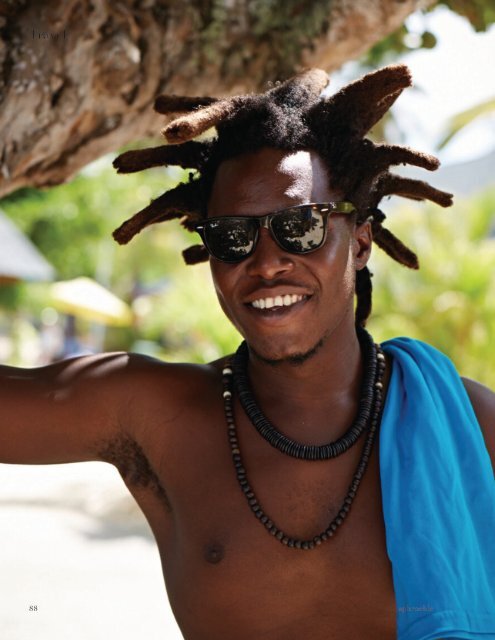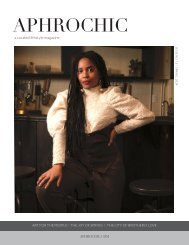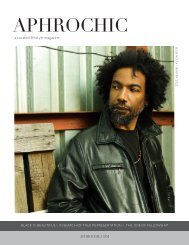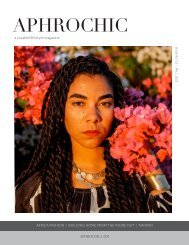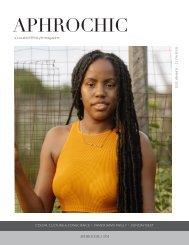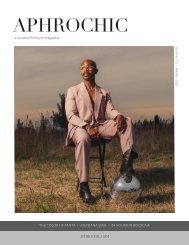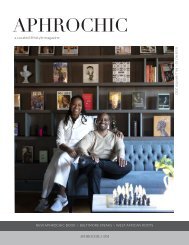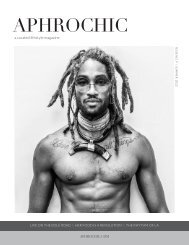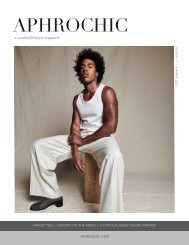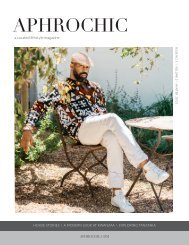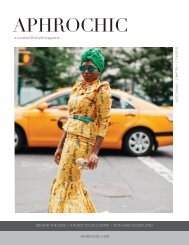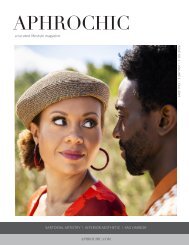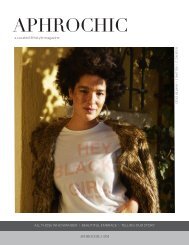AphroChic Magazine: Issue No. 4
In this issue, we sit down with artist, Malik Roberts, who relates the experience of creating one of the few African American artworks to sit permanently in the Vatican collection. Fashion designer, Prajjé Oscar John-Baptiste introduces his latest collection — an ode to Haiti, and its goddesses. We head to South Carolina to experience the Gullah-inspired music of Ranky Tanky. And in New York, we watch a new world being born with photographer and journalist, Naeem Douglass, who takes us inside the city’s Black Lives Matter protests, and economist Janelle Jones, who reminds us in these times that we are the economy. We are thrilled to share our cover with chef and musician, Lazarus Lynch. Inside, we talk with him about his cookbook, Son of a Southern Chef and his new album, I’m Gay. From a house tour in Brooklyn to a travel piece in Tobago, this issue takes you all over the Diaspora. And we see how of the concept of Diaspora was first introduced in a look back at how Pan-Africanism led the way to how we think of international Blackness today. It is a showcase of our culture, our creativity, our resilience, and our diversity, our demands for the present and our hopes for the future. Welcome to our summer issue.
In this issue, we sit down with artist, Malik Roberts, who relates the experience of creating one of the few African American artworks to sit permanently in the Vatican collection. Fashion designer, Prajjé Oscar John-Baptiste introduces his latest collection — an ode to Haiti, and its goddesses. We head to South Carolina to experience the Gullah-inspired music of Ranky Tanky. And in New York, we watch a new world being born with photographer and journalist, Naeem Douglass, who takes us inside the city’s Black Lives Matter protests, and economist Janelle Jones, who reminds us in these times that we are the economy.
We are thrilled to share our cover with chef and musician, Lazarus Lynch. Inside, we talk with him about his cookbook, Son of a Southern Chef and his new album, I’m Gay.
From a house tour in Brooklyn to a travel piece in Tobago, this issue takes you all over the Diaspora. And we see how of the concept of Diaspora was first introduced in a look back at how Pan-Africanism led the way to how we think of international Blackness today. It is a showcase of our culture, our creativity, our resilience, and our diversity, our demands for the present and our hopes for the future. Welcome to our summer issue.
You also want an ePaper? Increase the reach of your titles
YUMPU automatically turns print PDFs into web optimized ePapers that Google loves.
Travel<br />
Tobago is beautiful. With lush rainforests, towering mountains and<br />
endless beaches, it is beautiful in a way rivaled only by those few places<br />
equally fortunate to be located somewhere in the Caribbean Sea. It’s easy<br />
to believe that when Christopher Columbus first set foot on the island in the<br />
last years of the 15th century, that the beauty of the place was the first thing<br />
he noticed. Despite all the harm he caused, and all that transpired after as<br />
colonial powers struggled to control it, the island, which was conquered and<br />
reconquered more than thirty times, remains beautiful. Linked to Trinidad<br />
since the 1800s, the twin nations entered freedom together, liberated from<br />
British control in 1962, becoming a joint republic in 1976.<br />
At only 116 square miles, Tobago offers a startling variety of natural<br />
terrains. In addition to rainforests, mountains and beaches, the island is<br />
home to foothills, plains, mangrove swamps, waterfalls, and coral reefs.<br />
Its historical imprint is wide as well as it shares with Trinidad the pride of<br />
adding CLR James, Eric Williams, and Henry Sylvester Williams, among<br />
others to the international college of thinkers, activists and politicians who<br />
have shaped our collective notion of Blackness through their work.<br />
The island’s true treasures, however, are its people and culture. What<br />
Tobago calls its own are its traditional dances — the salaka, the reel, and the<br />
jig — and tambrin, the uniquely Tobagonian musical style that often accompanies<br />
them. Festivals and celebrations commemorate the history of the<br />
island and the culture of the people, highlighting what is uniquely their own<br />
while honoring the connection to Africa that unites us all.<br />
After centuries of colonization, the long fight for freedom and the work<br />
of creating a new culture, through it all the beauty of the Tobago, its people<br />
and heritage are plain to see. AC<br />
88 aphrochic issue four 89


